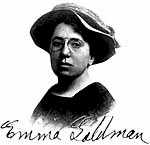Emma Goldman
(1869–1940) is remembered as one of America’s most eloquent proponents
of anarchism. She was born in a Jewish ghetto in Russia. In 1884 she came to
Rochester, New York, where she worked in a sweatshop and got a first-hand look
at the “American Dream” of the late 19th century industrial
working class.
What initially drew Goldman
to anarchism was the outcry that followed the Haymarket Square tragedy in 1886
in Chicago. A bomb had been thrown into a crowd of police during a workers’
rally for the 8-hour day. Four anarchists were eventually hanged. Emma Goldman
had followed the event closely and as the day on the day of the hanging she
decided to become a revolutionary.
In New York City she met
Johann Most , publisher of a German language anarchist paper, who organized a
series of speaking engagements for her. She also worked with Alexander
Berkman
, publisher of a German language anarchist paper, who organized a
series of speaking engagements for her. She also worked with Alexander
Berkman ,
author of The ABCs of Anarchism, and Peter
Kropotkin
,
author of The ABCs of Anarchism, and Peter
Kropotkin , author of Mutual
Aid: A Factor of Evolution
, author of Mutual
Aid: A Factor of Evolution .
.
In 1893 she was arrested for
allegedly urging the unemployed to take bread “by force” and was sentenced
to a year in Blackwell Island penitentiary. She was imprisoned a second time
for distributing birth control literature, but her longest sentence resulted
from her involvement in setting up “No Conscription” leagues and
organizing rallies against the first world war. Goldman and Berkman were
arrested in 1917 for conspiring to obstruct the draft, and both were given two year
prison sentences.
Afterwards they were stripped of their citizenship and deported along with
other undesirable “Reds” to Russia. FBI director J. Edgar Hoover, who
directed her deportation hearing, called her one of the most dangerous women
in America.
Emma Goldman made a number
of important contributions to anarchist thought. In particular she is
remembered for incorporating sexual politics into anarchism, an idea that had
only been hinted at by earlier anarchists. Goldman campaigned and went to
prison for the right of women to practice birth control. She argued that a
political solution was not enough to get rid of the unequal and repressive
relations between the sexes. There had to be massive transformation of values,
most importantly in women themselves. Only anarchist revolution and not the
ballot, in Emma’s view, would set woman free.
Emma recounts in her
autobiography, Living My
Life , how she was admonished by a young
revolutionary that it did not become an agitator to dance. Goldman wrote, “I
insisted that our cause could not expect me to behave as a nun and that the
movement should not be turned into a cloister. If it meant that, I did not
want it. I want freedom, the right to self expression, everybody’s right to
beautiful, radiant things.”
, how she was admonished by a young
revolutionary that it did not become an agitator to dance. Goldman wrote, “I
insisted that our cause could not expect me to behave as a nun and that the
movement should not be turned into a cloister. If it meant that, I did not
want it. I want freedom, the right to self expression, everybody’s right to
beautiful, radiant things.”

